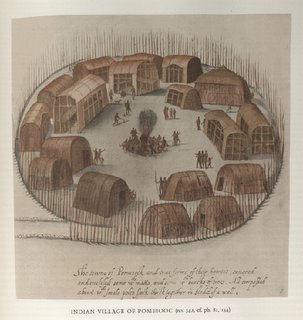Poor Johnny White
 John White is one of the more tragic figures of the early colonial period in North America. His story begins with the discovery of Roanoke Island (now off North Carolina) by ships financed by Sir Walter Raleigh in 1584. The following year, Raleigh sent 107 men to Roanoke to colonize and John White went along as one of Raleigh's publicity team; he was designated by Raleigh to paint pictures of the new colony to attract funds and pioneers. His watercolors (including the accompanying illustrations of "Indians dancing around a circle of posts" and the "Indian Village of Pomeiooc") are obviously the product of a lively and wide-awake mind and contain a kind of Brueghelesque joy.
John White is one of the more tragic figures of the early colonial period in North America. His story begins with the discovery of Roanoke Island (now off North Carolina) by ships financed by Sir Walter Raleigh in 1584. The following year, Raleigh sent 107 men to Roanoke to colonize and John White went along as one of Raleigh's publicity team; he was designated by Raleigh to paint pictures of the new colony to attract funds and pioneers. His watercolors (including the accompanying illustrations of "Indians dancing around a circle of posts" and the "Indian Village of Pomeiooc") are obviously the product of a lively and wide-awake mind and contain a kind of Brueghelesque joy. After suffering through a horrible year of starvation and Spanish and Indian attacks, John White and all of the rest of the surviving colonists returned to England with Francis Drake (who was just passing through; meanwhile, a few weeks later, one of Raleigh's captains arrived to find an abandoned colony and left 15 men behind to search for the colonists who returned with Drake). White's engravings of Roanoke illustrated Raleigh's commissioned travel brochure, the Briefe and True Report of the new found land of Virginia (written by Thomas Harriott; 1588).
After suffering through a horrible year of starvation and Spanish and Indian attacks, John White and all of the rest of the surviving colonists returned to England with Francis Drake (who was just passing through; meanwhile, a few weeks later, one of Raleigh's captains arrived to find an abandoned colony and left 15 men behind to search for the colonists who returned with Drake). White's engravings of Roanoke illustrated Raleigh's commissioned travel brochure, the Briefe and True Report of the new found land of Virginia (written by Thomas Harriott; 1588).White returned as "governor" to Roanoke with a band of 120 fresh colonists (including his wife and daughter) in 1587, finding no trace of the 15 men left the previous year. Very soon after arriving, White decided that 2 men should go back to England to secure additional supplies for the coming winter, but the colonists decided White himself should go. Reluctantly, he bade goodbye to his wife, his daughter and his newborn granddaughter, Virginia Dare (called, by tradition, the first English child born in North America) and set sail for England.
When he arrived he found England in the middle of its war with Spain, and White spent three agonizing years awaiting a ship to carry him back to Roanoke. When he arrived back in Roanoke in July 1590, not a soul was to be found -- no bodies, no signs of destruction or struggle, not even the agreed-upon distress signal of a cross.
What had happened to the Roanoke colonists? Surprisingly, there is good evidence that they were not massacred. In 1719, white settlers in Robinson County, North Carolina (100 miles inland from Roanoke) encountered a strange tribe of light-skinned, blue-eyed Indians who spoke English; the 1790 census moreover shows that 54 of the 95 family names in the County were those of people among the lost Roanoke colonists. The indications are that the colonists sought refuge with the friendly Croatan Indians nearby, and peacefully assimilated with them.
Such archaeological musings came too late to offer comfort to John White, who returned to England, and piteously faded from history -- likely as one of Raleigh's lieutenants in Ireland.
Labels: Colonial History





1 Comments:
Ron/Dad You are picking up a fan club and a lot of them that dont answer. I knew the name Verginia Dare ,but couldnt remember from where.I hope you are having fun with my spelling.
Post a Comment
Subscribe to Post Comments [Atom]
<< Home